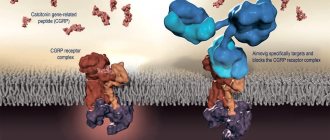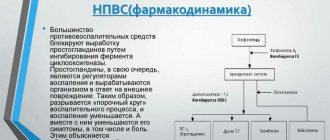Nomigren
A combined drug for relieving headache attacks of vascular origin, it helps people with migraine well. Nomigren is a relatively safe drug that contains propyphenazone, caffeine, ergotamine, meclosamine and kamilofin. "Nomigren" relieves headaches not only of a migraine nature - it is an antispasmodic and analgesic. When taking Nomigren for the first time, choose the minimum dosage, since the list of contraindications and side effects of the drug, despite its relative safety, is large.
Nomigren
Bosnalek, Bosnia and Herzegovina
acute attacks of migraine (including those accompanied by an aura);
migraine-like headaches of vascular origin. from 127
5.0 3 reviews
1013
- Like
- Write a review
What causes migraines?
Researchers have not determined the cause. They have found some contributing factors that may lead to this disease. These include changes in brain chemicals, such as a decrease in the amount of serotonin in the brain.
Other factors that can cause migraines include:
- bright lights
- extreme heat or other extreme weather conditions
- dehydration
- changes in atmospheric pressure
- hormonal changes in women, such as fluctuations in estrogen and progesterone during menstruation, pregnancy, or menopause
- excessive stress
- loud sounds
- intense physical activity
- skipping meals
- changes in sleep patterns
- using certain medications such as oral contraceptives or nitroglycerin
- unusual smells
- certain food
- smoking
- alcohol consumption
- trips
If you suffer, your doctor may ask you to keep a headache journal. Writing down everything you did, what food you ate, and what medications you took before your migraine started can help identify your triggers.
Foods that cause migraines
Some foods or food ingredients are more likely to cause it than others. They include:
- alcoholic or caffeinated drinks
- food additives such as nitrates (a preservative in cured meats), aspartame (an artificial sugar), or MSG
- tyramine, which is found in some natural foods
Tyramine also increases when foods begin to ferment or are aged. This includes foods such as some aged cheeses, sauerkraut and soy sauce. Ongoing research is looking more closely at the role of tyramine in migraines. For some people it may be a headache protector, but for others it may be a headache trigger.
Migrepam
The main active ingredient of Migrepam is zolmitriptan. This anti-migraine drug targets exactly the cause of the headache, so it helps to cope with even long-term migraines and severe episodes of headaches. In addition to headaches, Migrepam also relieves symptoms such as fear of light and sensitivity to sounds, nausea and sweating. Improvement occurs approximately an hour after taking the tablet. But not everyone can use this drug due to side effects. Therefore, be sure to consult your doctor before purchasing Migrepam.
Migrepam
Migrepam® effectively relieves headaches and other symptoms of migraine (nausea, photophobia, phonophobia).
Equally effective against migraine with aura, without aura and migraine associated with menstruation. from 166
344
- Like
- Write a review
Differences from migraine without aura
Migraine without aura is called “classic”. Approximately 80% of patients suffer from it. A migraine without an aura manifests itself as throbbing pain at one point. It is not preceded by any visual, auditory or sensory impairment. Sometimes people don’t even realize that it’s a migraine, but think that they just have a headache. For this reason, patients do not go to the doctor, which is fraught with consequences.
You have migraine without aura if the following symptoms are present:
- 5 episodes of pain.
- The attacks last from 4 to 72 hours if you do not take medication.
- The pain throbs and is concentrated on one side of the head. The forehead, neck, and then the face or back of the head may hurt.
- With any physical activity the pain gets worse.
- There may be nausea, fear of light, sounds, voices.
Sumamigren
This drug contains the substance sumatriptan, which has serotin-generating and anti-migraine effects. The headache is relieved quickly because vasoconstriction occurs selectively. Sumatriptan is a truly effective substance that helps quickly get rid of a migraine attack. “Sumamigren” contains only 50 mg of sumatriptan, so during an intense migraine attack you can take two tablets at once. Moreover, the headache will go away in about 15-20 minutes. But Sumamigren has serious contraindications and side effects, so it must be prescribed by a doctor.
Sumamigren
Polfa, Poland
Relief of migraine attacks with or without aura.
from 206
448
- Like
- Write a review
Migraine in children
Non-drug therapy
Pediatric neurologists recommend first adjusting your lifestyle: wisely balance physical and mental activity, avoid stress and family conflicts, and ensure a good night's sleep. In the diet, reduce the number of caffeinated drinks, spicy foods, chocolate and nuts, since these products provoke migraine attacks. If necessary, psychotherapeutic correction, exercise therapy and relaxing massage are prescribed.
Conservative therapy
Treatment of migraine in children consists of 2 phases: attack relief and anti-relapse therapy. To eliminate painful symptoms, drugs from the group of non-steroidal anti-inflammatory drugs (paracetamol, ibuprofen, metamizole sodium) are mainly used. NSAIDs successfully cope with pain of moderate intensity. Second-line therapy includes selective serotonin receptor agonists, caffeine combination agents, beta blockers, and calcium channel blockers.
Treatment with analgesics requires caution to avoid drug-induced headache. Taking NSAIDs is allowed no more than 12 times a month, and using drugs of the second group is allowed up to 2 times a week. To stop vomiting during the attack period, treatment is carried out with specific antiemetics. Taking these medications significantly improves the child’s well-being and increases the effectiveness of pain relief.
Preventive treatment of migraine is recommended when cephalgia in children increases up to 2-3 times per month, and headaches last for more than 24-48 hours without a break. Indications for anti-relapse therapy include high intensity pain syndrome, which significantly interferes with the child’s daily activity, the presence of comorbid pathologies such as insomnia, anxiety disorders, and obesity.
During the interictal period, therapy includes several groups of drugs: antihistamines, antidepressants, anticonvulsants. In adolescents, drug treatment lasts at least 6 months; in primary school age, therapy begins with short courses of 8-12 weeks. To prevent side effects, medications are prescribed in minimal therapeutic doses, gradually increasing the dosage.
Experimental treatment
In the USA and Europe, a new group of drugs has been developed - monoclonal antibodies to calcitonin gene-related peptide (CGRP), which is involved in the pathophysiology of a neurovascular pain attack. The treatment is at the stage of clinical trials in pediatric practice, but doctors can already judge its effectiveness in preventing relapses and chronicity of the process.
Amigrenin
The active ingredient of Amigrenin is also sumatriptan, but in a higher dosage than the previous medicine. Amigrenin quickly relieves migraine symptoms, not only headaches, but also other symptoms. Moreover, if you take a pill at the beginning of the aura, you can even avoid a headache. The drug contains a high dosage of sumatriptan - 100 mg - which is why Amigrenin has such a large list of contraindications.
Amigrenin
Veropharm / Lance-Farm, Russia
The active substance of the drug Amigrenin interacts with type I 5-hydroxytryptamine receptors located in the smooth muscles of the walls of blood vessels in the brain, selectively constricts blood vessels in the carotid artery system, and inhibits the activity of the trigeminal nerve.
All this helps reduce the severity of migraine pain. The clinical effect is observed after 30 minutes. from 187
701
- Like
- Write a review
Diagnosis of migraine with aura
The diagnosis is made by a neurologist, and it is he who should be contacted with such a problem as soon as possible. The doctor must rule out cysts, tumors, encephalitis and vascular pathologies that cause similar symptoms. Therefore, a neurological examination, CT or MRI of the brain is performed, and the patient is sent for a consultation with an ophthalmologist for examination and determination of visual fields.
An EEG (electroencephalography) is required, which provides information about the functional activity and characteristics of the brain biorhythm of a particular patient. Based on the EEG results, the doctor then selects medications for therapy.
Sumatriptan
This drug is one of the best in the fight against persistent migraine. The active ingredient of the drug is sumatriptan succinate. "Sumatriptan" selectively constricts blood vessels without affecting cerebral blood flow. The drug not only relieves headaches, but also helps relieve other symptoms of migraine: sensitivity to light and noise, nausea. The migraine subsides just 15 minutes after taking the pill. Sumatriptan is a drug with a stable effect, so migraine attacks do not return for a long time after taking it.
Sumatriptan
Migraine pain
People describe the pain as:
- pulsating
- Rhythmic
- Drilling
- Beating
- Exhausting
It can also be severe and dull, but long-lasting. The pain is mild at first, but without treatment it will increase from moderate to severe.
Migraine pain most often affects the forehead area. As a rule, on one side of the head, but maybe on both, or alternately. Most migraines last about 4 hours. If they are untreated or do not respond to treatment, they can last from 72 hours to a week. With an aura, pain is replaced by an aura or does not occur at all.
Migrainous status
In this case, headaches have the nature of painful attacks, are accompanied by neurological symptoms, and last for several days.
Another option for the development of the disease is a migraine attack that lasts for three days and does not go away after taking medications. In this case, headaches are accompanied by:
- vomiting;
- signs of dehydration;
- decreased vision or loss of visual fields;
- apathy;
- convulsive seizures are possible;
- fainting.
Migraine and pregnancy
For many women, migraines ease slightly during pregnancy. However, after childbirth it may become worse due to sudden hormonal changes. Headaches during pregnancy require special attention to properly understand the causes of their occurrence.
Research is ongoing, but a recent small study found that women who experience migraines during pregnancy are more likely to:
- premature or early birth
- preeclampsia
- giving birth to an underweight child
Some medications are not recommended to be taken during pregnancy. For example, aspirin. If you experience migraines during pregnancy, talk to your doctor to find treatment options that won't harm your baby.










